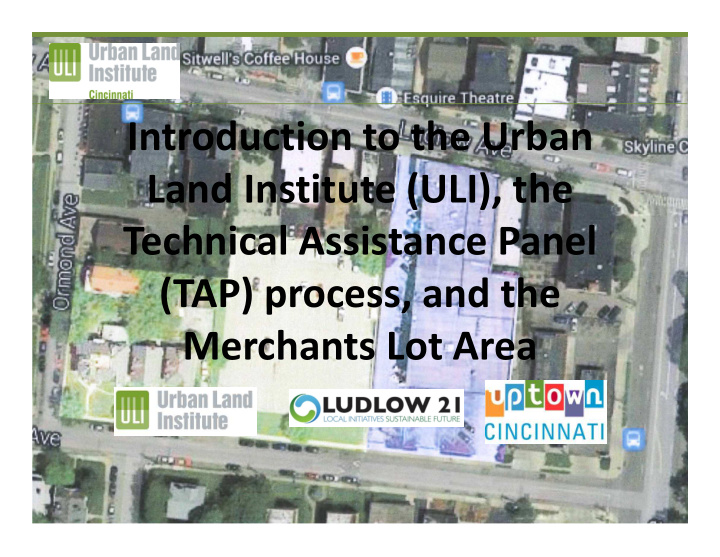



Introduction to the Urban Land Institute (ULI), the Technical Assistance Panel (TAP) process, and the Merchants Lot Area
What/Who is the An independent global nonprofit supported by members since 1936, ULI today has more than 33,000 members worldwide (240 locally), representing the entire spectrum of the land use and development disciplines. ULI provides leadership in the responsible use of land and in creating and sustaining thriving communities worldwide. ULI is committed to: • Bringing together leaders from across the fields of real estate and land use policy to exchange best practices and serve community needs; • Fostering collaboration within and beyond ULI’s membership through mentoring, dialogue, and problem solving; • Exploring issues of urbanization, conservation, regeneration, land use, capital formation, and sustainable development; • Advancing land use policies and design practices that respect the uniqueness of both the built and natural environments; • Sharing knowledge through education, applied research, publishing, and electronic media; and • Sustaining a diverse global network of local practice and advisory efforts that address current and future challenges. cincinnati.uli.org
Technical Assistance Panels (TAPs) • TAPs are designed on a local level in collaboration with the sponsor and stakeholders and are ½ -day to day sessions that leverage local knowledge to study land use challenges. • Cincinnati ULI membership provides access to the best and brightest talent, often high-level land use and real estate executives in the industry, for eligible entities and groups to bring their expertise into local communities. • A TAP includes six or more ULI members to provide in-depth analysis, dialogue and tools needed to bring ideas and concepts forward, vet existing concepts, and help move projects from the backburner to full steam ahead. • Panel member expertise includes developers and owners, investors, architects, designers, engineers, and executives from some of Cincinnati’s largest banks, commercial real estate and consulting firms. cincinnati.uli.org
Merchants Lot • ~1.5 acres in the Clifton/Ludlow Business District. • Evaluate the wants and needs of the community vs. what the market will sustainably support. • Opportunity to plan and redevelop an important part of the community and tie into other plans and concepts to enhance the district and its gateway/entrance. cincinnati.uli.org
Example Visualizations (from other projects) cincinnati.uli.org
Example Visualizations (from other projects) cincinnati.uli.org
Example Visualizations (from other projects) cincinnati.uli.org
Why a TAP? • No pressure community discussion around pros/cons of development. What works, what doesn’t, and why. • Explore the reasons other Cincinnati business districts have thrived while Ludlow’s has stagnated. • Presents an opportunity to be proactive. Layer community “wish list” with what is viable to set expectations for future interactions with interested tenants or developers. cincinnati.uli.org
TAP Process • Assemble the available information to support the TAP review, identify data gaps and how to fill. • Ludlow 21 Plan, 1994 Ludlow Master Plan, Ludlow 21 Survey. • Organize List of ULI Member Participants & Stakeholders. • Schedule TAP Session: a full day of study and discussion with formal written report as deliverable as well as graphics and visualizations. Tentatively scheduled for March 16 th . • Deliverable Report: typically 6 to 12 weeks from scoping to convening of TAP and then deliverable. • Ludlow 21 Presentation: The TAP team will then present their findings and report at a yet to be scheduled Ludlow 21 meeting. cincinnati.uli.org
TAP Participants ULI Member Volunteers • Multi-Family Housing (Dave Lockard) • Developer (Deron Kintner) • Planners (Frank Russell & Joe Nickol) • Engineer (Jim Zentmeyer) • Construction (Paula Dombrowski) • Architect (Steve Kenat) • Economic Development (Melissa Johnson) Community Stakeholders • City of Cincinnati, Clifton Business & Professional Association, Clifton Market, Clifton Town Meeting, Ludlow 21, Uptown Consortium cincinnati.uli.org
What Do We Hope To Accomplish? • Review community desires alongside market realities using best practices as a benchmark. • Develop a massing study for the site that takes into account the needs of adjacent businesses, customers, residents, zoning, and the site’s current role as public parking. • Set the table for a larger Ludlow Master Plan to update / replace the 1994 plan. cincinnati.uli.org
Recommend
More recommend